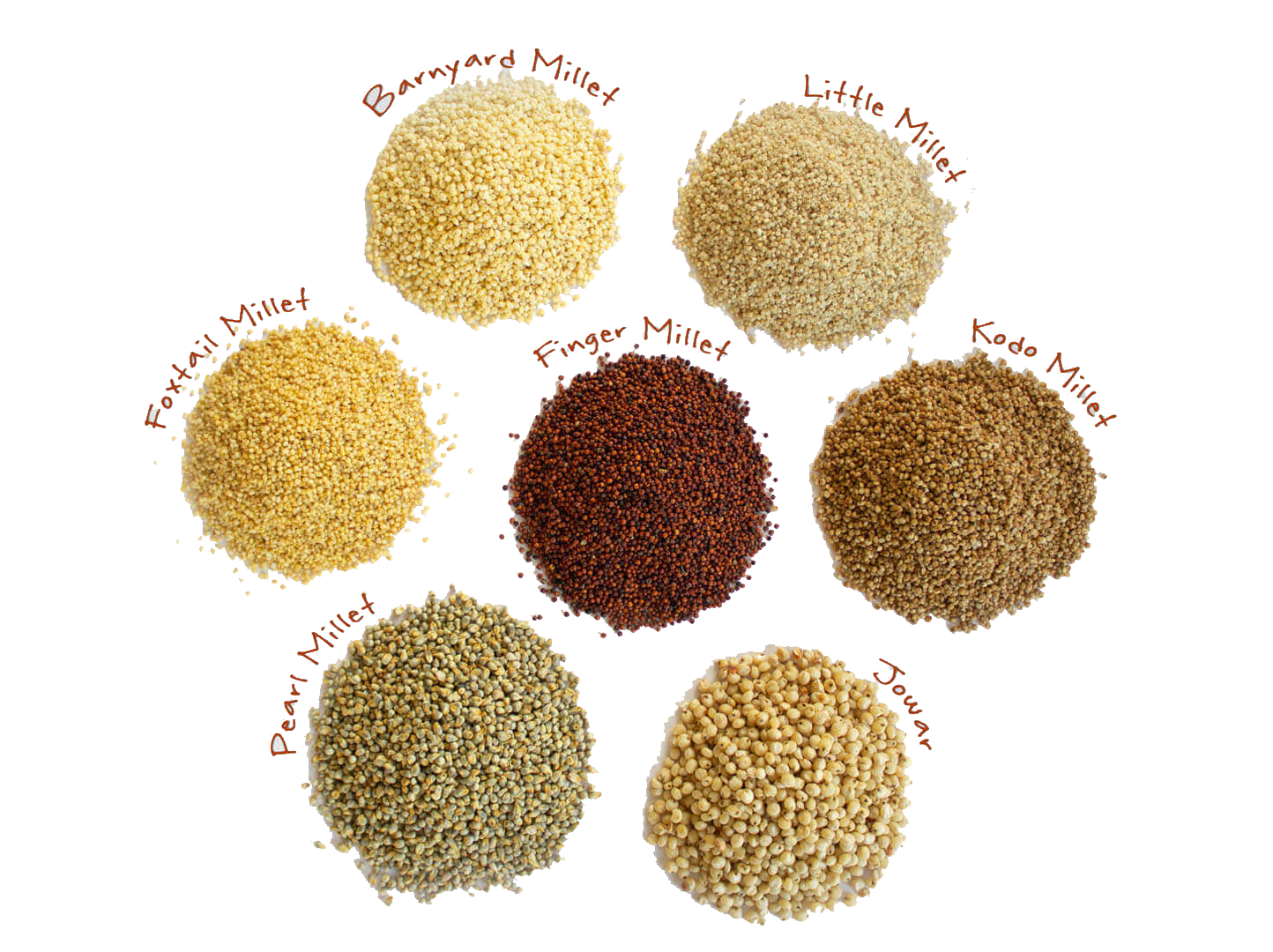For a Healthier Future

Background of Millets:
- Indian millets are a group of nutritiously rich, drought tolerant, and mostly grown in India's arid and semi-arid regions. They are small-seeded grasses belonging to the botanical family Poaceae. Indian Millets are nutritionally superior to wheat and rice as they are rich in protein, vitamins, and minerals. They are also gluten-free and have a low glycemic index, making them ideal for people with celiac disease or diabetes.
- India is the largest producer as well as the largest exporter of cereal products in the world and there are several millet sourcing points located throughout the country. The main millet-growing states in India are Karnataka, Andhra Pradesh, Rajasthan, Maharashtra, and Madhya Pradesh. These states have many millet farmers who grow grain for both domestic and international markets.
Millet grains and their significance:
- Diverse Varieties: Millets encompass a wide range of species, including sorghum, pearl millet, finger millet, and several minor millets like barnyard, proso, kodo, and foxtail. This diversity provides various options for cultivation and consumption, catering to different climates and dietary preferences.
- Early Domestication: Millets were among the first crops to be domesticated by humans. Their long history of cultivation speaks to their adaptability and suitability for a variety of growing conditions.
- Traditional Food Source: Millets have been a staple food source for millions of people in Sub-Saharan Africa and Asia for over 7,000 years. They have played a crucial role in the diets and cultures of these regions, providing sustenance and nutrition.
- Global Cultivation: While their origins are in Africa and Asia, millets are now grown worldwide. Their ability to thrive in diverse climates, particularly in arid and semi-arid regions, makes them an essential crop for food security in many parts of the world.
- Nutritional Powerhouses: Millets are highly nutritious, often surpassing wheat and rice in terms of protein, fiber, vitamins, and minerals. They are a good source of essential nutrients like iron, calcium, and B-vitamins.
- Drought Tolerance: Drought Tolerance: Millets are known for their drought tolerance. They require less water compared to major cereal crops like rice and wheat, making them a valuable option in regions with limited water resources.
- Gluten-Free: Millets are naturally gluten-free, making them an excellent choice for individuals with celiac disease or gluten sensitivity.
- Low Glycemic Index: They have a low glycemic index, which means they have a slower and steadier impact on blood sugar levels. This is beneficial for individuals with diabetes and for maintaining overall health.
- Biodiversity and Sustainability: The cultivation of various millet species contributes to agricultural biodiversity and helps in maintaining a balanced ecosystem. Additionally, their low water requirements and ability to grow in marginal lands contribute to sustainable agriculture practices.
Overall, millets hold immense potential in addressing global food security challenges, improving nutrition, and promoting sustainable agriculture. Their versatility and adaptability make them a valuable addition to modern agricultural practices.
Nutritional Benefits:
- Rich Source of Carbohydrates and Dietary Fiber: Millets are excellent sources of complex carbohydrates and dietary fiber, providing sustained energy release and aiding in digestion.
- Micronutrient Powerhouses: They are packed with essential micronutrients such as calcium, iron, zinc, and other minerals. These nutrients are crucial for maintaining overall health and preventing deficiency-related conditions.
- Protein Content: Millets are relatively high in protein compared to other staple crops like rice and wheat. This makes them an important protein source, especially for vegetarian or vegan diets.
- Healthy Fats: They contain a moderate amount of healthy fats, contributing to a balanced diet.
- Phytochemicals with Nutraceutical Properties: Millets are rich in bioactive compounds like antioxidants, which have potential health benefits beyond basic nutrition.
Ecological Benefits:
- Drought Tolerance: Millets are inherently drought-tolerant crops. They require significantly less water compared to major cereals like rice, which helps conserve water resources, especially in regions facing water scarcity.
- Soil Health and Biodiversity: Millets contribute to soil health by promoting microbial diversity and reducing soil erosion. Their cultivation supports biodiversity by providing habitat and food sources for various organisms.
- Crop Rotation and Sustainability: Millets can be an integral part of crop rotation systems, helping break disease and pest cycles, improving soil fertility, and promoting sustainable agricultural practices.
- Reduced Chemical Input: Due to their natural resilience to pests and diseases, millets often require fewer chemical inputs, reducing the environmental impact of agriculture.
Economic Benefits:
- Livelihoods and Income Generation: Millet cultivation supports livelihoods of farmers, particularly in regions where these crops are a staple. It provides a source of income and food security.
- Market Opportunities: As millets gain popularity for their health benefits, there is an increasing demand for these grains in both domestic and international markets. This can be a lucrative opportunity for farmers and traders.
- Reduced Production Costs: Millets' adaptability to diverse environments and their low input requirements (such as water and fertilizers) can lead to reduced production costs for farmers.
- Resilience to Climate Change: Given their resilience to adverse conditions, millets can serve as a buffer against the impacts of climate change on agriculture, providing a more stable income for farmers.
Overall, the combined nutritional, ecological, and economic benefits of millets make them a valuable addition to global agriculture and nutrition strategies. Their promotion and cultivation can play a significant role in improving food security, nutrition, and environmental sustainability.
